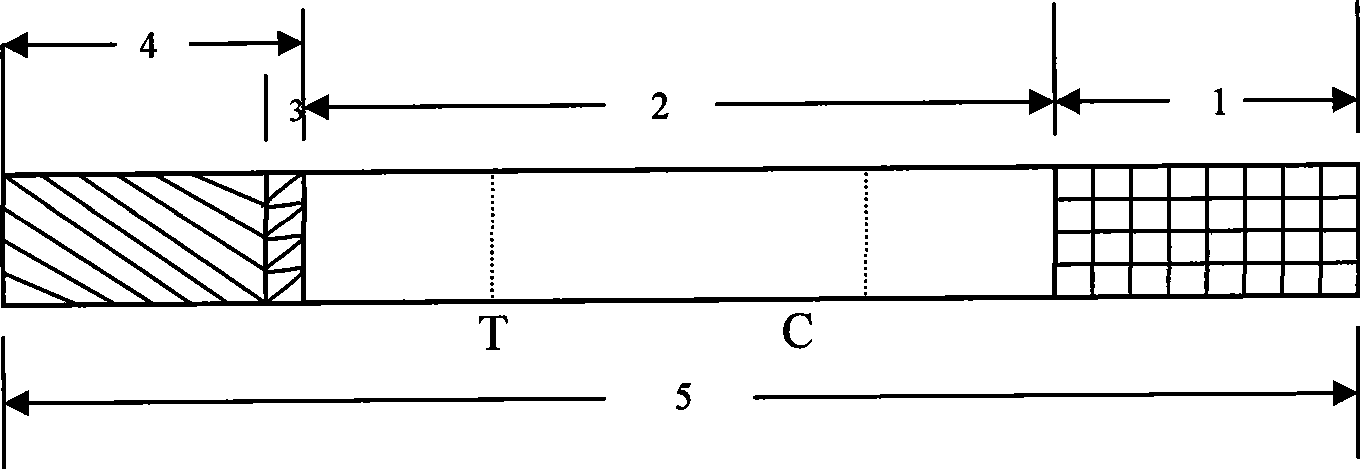Rapid detection test strip for detecting campylobacter jejuni specific antigen
A technology of Campylobacter jejuni and test strips, applied in applications, measuring devices, anti-bacterial immunoglobulins, etc., can solve problems such as limited significance of clinical diagnosis, achieve convenient storage and transportation, and have industrial effects
- Summary
- Abstract
- Description
- Claims
- Application Information
AI Technical Summary
Problems solved by technology
Method used
Image
Examples
Embodiment 1
[0035] Example 1: Preparation of Genetic Engineering Antigen of Campylobacter jejuni Outer Membrane Protein PEB1
[0036] Extraction of CJ Genomic DNA:
[0037] Take 1ml of Campylobacter jejuni culture, centrifuge to collect cells, then suspend in 200ul TE solution, and extract DNA with Genomic DNA Extraction Kit.
[0038] Amplification of the peblA gene
[0039] According to the complete CDS of peblA reported by Genbank (No. AL139076), a pair of primers were designed by removing the signal peptide at the amino terminal, and BamHI and XhoI were selected as restriction sites to design the following primers:
[0040] Upstream is 5-GCGGATCCGCAGAAGGTAAACTTGAGTCTAT-3,
[0041] Downstream is 5-CCGCTCGAGTTATAAACCCCATTTTTTCGCT-3.
[0042] PCR amplification of the peblA gene. The amplification conditions were denaturation at 94°C for 4 minutes, denaturation at 94°C for 30 seconds, annealing at 53°C for 45 seconds, extension at 72°C for 1 minute, and extension at 72°C for 8 minutes ...
Embodiment 2
[0051] Rabbit anti-CJ whole bacteria antibody was used as the primary antibody; HRP-labeled goat anti-rabbit IgG was used as the secondary antibody, and Western blot was used to detect the immunoreactivity of rPEB1. The results showed that the recombinant protein Peb1 had good immunogenicity, and the ELISA titer of its rabbit serum reached 1:50000. Example 2: Preparation of monoclonal antibody against Campylobacter jejuni outer membrane protein PEB1
[0052] (1) Immunized mice
[0053] After the prepared genetically engineered antigen was taken out from the -20 low-temperature refrigerator and dissolved, it was subcutaneously injected into the back of BALB / C mice (0.2ml / only) with an interval of 10 days. Three days before the fusion, mice were challenged with 0.15 ml of antigen in the peritoneal cavity. The immune effect was detected by ELISA method.
[0054] (2) Myeloma cells
[0055] SP2 / 0 myeloma cells: resuscitate SP2 / 0 cells stored in a liquid nitrogen tank, and cultu...
Embodiment 3
[0064] Example 3: Detection of anti-Campylobacter jejuni outer membrane protein PEB1 monoclonal antibody
[0065] (1) Monoclonal antibody ascites preparation:
[0066] Mice: SPF grade mice, no rodent virus contamination after inspection, if the animals are found to be unhealthy, bitten or infected during the ascites production process, they should be discarded.
[0067] Expanded culture of cell lines: take one tube of the production batch of cells to resuscitate, add nutrient solution to expand the culture, one production cell is only used once, and will not be frozen.
[0068] Inoculation of hybridoma cell lines: preparation of ascites should be carried out under sterile conditions, before injection of hybridoma cells, each mouse was intraperitoneally injected with liquid paraffin 0.5ml. One week later, each mouse was intraperitoneally injected with hybridoma cells 1-3×10 6 / 0.2ml.
[0069] Ascites collection: 7-10 days after the injection of the cell line, or the ascites ...
PUM
 Login to View More
Login to View More Abstract
Description
Claims
Application Information
 Login to View More
Login to View More - Generate Ideas
- Intellectual Property
- Life Sciences
- Materials
- Tech Scout
- Unparalleled Data Quality
- Higher Quality Content
- 60% Fewer Hallucinations
Browse by: Latest US Patents, China's latest patents, Technical Efficacy Thesaurus, Application Domain, Technology Topic, Popular Technical Reports.
© 2025 PatSnap. All rights reserved.Legal|Privacy policy|Modern Slavery Act Transparency Statement|Sitemap|About US| Contact US: help@patsnap.com



